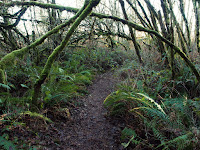 |
| Tualatin Hills Nature Park |
By mid-winter, where we are now, our dedicated wildflower search team starts to get antsy. Even though we are having a very mild winter here in western Oregon, nothing native is blooming. Of course, nature does not come to a complete stop in winter, nor do we; well I supposed we do stop at times, for example when the old cat won't get off a cozy lap. But when we do get out on the trail, we strive to discover new areas to re-visit during the blooming season. That also gets us on our feet and moving around in nature - always a good thing for the mind and soul.
If you live in western Oregon then you know that nearly any mid-winter forest walk will take on a greenish-brownish look. The conifers are green, the moss is green, the ferns are green, and all the dead leaves on the ground are brown. Luckily there are usually frequent creeks, streams, and waterfalls to break this monophonic scenery. Other natural colors are hard to come by; but they are there if you know where to look and you get lucky. For example, we found this Orange Jelly fungus (
Dacrymyces palmatus) oozing out of a stump at T.H.N.P.
 |
| Jelly for your toast? |
You could say there are two kinds of moss people: those who hate moss because it gets in their lawns, mucks up the roof, and covers the walkways; and those who see it as an attractive native plant, doing its part for the damp habitat we occupy. There are about 700 different species of moss in our area, and all are abundant at all elevations. Here are a couple of very common ones living in our local parks.
 |
Menzies Neckera (Metaneckera menziesii) covers a
White Oak at T.H.N.P. |
 |
Cat Tail Moss (Isothecium myosuroides) covers old
Vine Maples at Noble Woods Park |
If you're looking to soak up some knowledge about Bryophyta plants (moss), see my posts from prior years (links below). Suffice to say, we live in the ideal environment for these curious flowerless and seedless plants. This year, we are featuring some photos from the Galen McBee Airport Park in McMinnville, Oregon. It's an obscure little park with a few walking trails and plenty of moss covered benches! It's a worthwhile stop if you are in the area.
The park is mostly natural but has a few curious structures.
There has to be a good story behind this mushroom hut!
The trails feature several whimsical water fountains that are
no longer functional. A small creek winds through the park.
At left, an old Big Leaf Maple is almost completely covered; at right,
a patch of lichen stakes a claim on this oak.
And last but not least, we spotted these mushrooms
caught in the late day sun near the creek.
Links:
2017 Annual Moss Edition
2016 Annual Moss Edition
2015 Annual Moss Edition
Newspaper Article about Airport Park (2017)


















